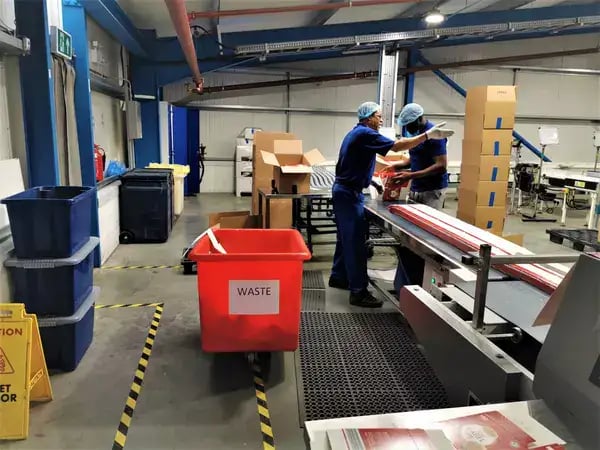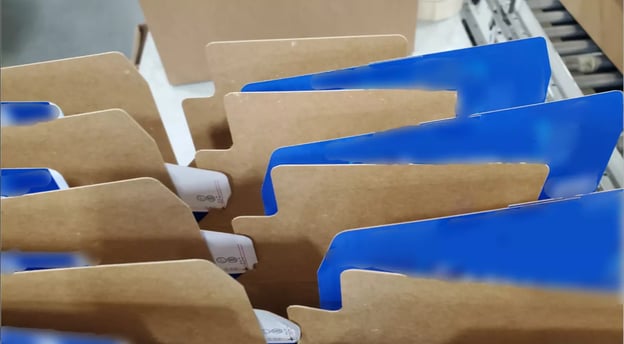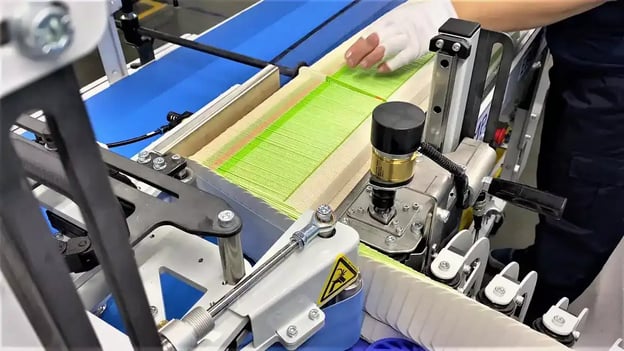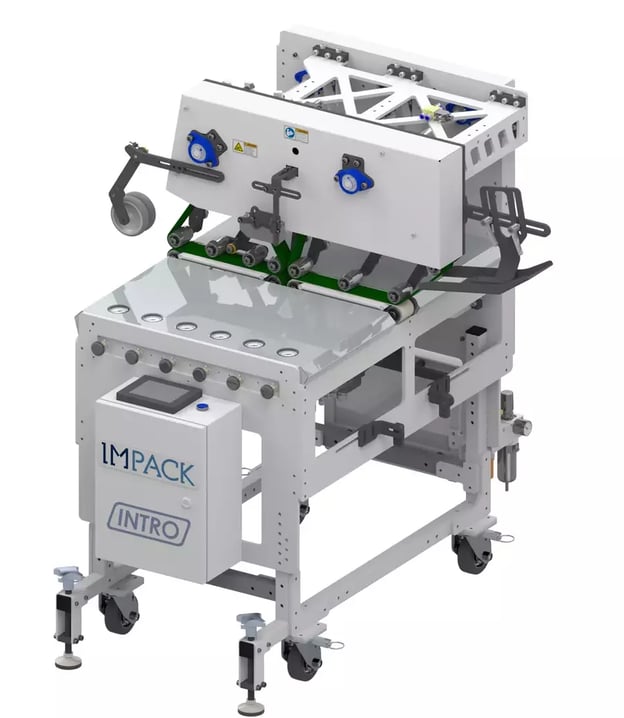Ergosa Vs. Virtuo Vs. Everio: Which is the Best Folder-Gluer Packer? [+VIDEO]
Are you in the market for a folder-gluer packer and looking for the perfect fit for your production?
10 min read
 Mathieu Tremblay
:
December 14, 2020
Mathieu Tremblay
:
December 14, 2020
![The 4 Most Common Folder-Gluer Packer Problems (+ Solutions) [+VIDEO]](https://impack.ca/hubfs/X21-005-1.png)
Are you thinking of getting a folder-gluer packer or automating the end of line process in your folding-gluing department?
For most of you, it’s probably the first time you’re considering automation. And that’s the most exciting part of the journey!
But before you even consider automation, it’s important that you do your research to have an idea of what you’re getting yourself into.
As the leader of packaging equipment design in folder-gluer lines, we’ve seen first-hand the most problematic issues with automation solutions.
Plus, we’ll tell you exactly how to solve them.

Note: These causes are “solution agnostic,” i.e., they apply no matter what level of automation your folder-gluer packer has and which partner you decide to go with.
Solution:
Solution:
Solution:
Solution:
Let’s face it:
Your folder-gluer will remain the master of your production no matter which post-gluing solution (packing system) you go with. And any post-gluing solution (packing system) you decide to go with is at the mercy of how well your folder-gluer is operating.
In other words, all packing systems (i.e. folder-gluer packers) are fully dependent on the working capabilities of your existing folder-gluer. So, if your gluer is outdated or not working as it should, it might not be able to operate with the flexibility, scope and operational efficiency as they could. And this may lead to problems in the future.
As the adage goes, “garbage in, garbage out.”

Your folding and gluing process is the core component of your production. In other words, maximizing your folder-gluer’s productivity should be your primary concern when thinking of automating your end of line process.
The process of tuning a folder-gluer is more akin to craftsmanship than automation. Increasing the output of your folder-gluer is never as easy as cranking up the speed dial of your gluer.
For example, when setting a complex box on the folder-gluer, it would take time to tune your gluer until you’ve reached a good production and consistency level.
The issue, though, is that when you are tuning the folder-gluer, either by setting a new box or making adjustments to increase the speed, you’re inevitably throwing garbage out.
A half-folded box here, a bunch of badly glued boxes there, boxes glued together, boxes torn apart, etc.
You know the drill!
On the contrary, when you’re running the process by hand without folder-gluer packers or with only a Collecting Table, it doesn’t matter as much. This is because the packing personnel would manage to sort the rejects, put them aside, and pack the good boxes.
But the more you go up the way of automation, the more these folder-gluer inconsistencies will have to be considered in the packing process.
For example, if you do not have automatic inspection or ejection systems, then all the rejects will get through the compression belt and reach the post-gluing equipment. If this equipment is fully automated, then there’s no one to sort the inconsistencies out. So they have to get through or else cause a jam. This jam causes a buildup of boxes in front of the box turner, a jam in the auto case packer, a jam in the stacker pusher, etc. If all the machines are connected together (which we strongly recommend) this eventually triggers a complete folder-gluer stop:
A perfect recipe for a production disaster.
Quite frankly, this is the worst-case scenario that can happen, but it does happen sometimes.
Fortunately, we’ve had the experience of going through those challenges over and over again in the last 20 years which made us well-equipped to face those issues head-on before, or when, they ever happen.
Ask for a pre-sale analysis: Find a folder-gluer packer manufacturer that would conduct a pre-sale analysis of your folder-gluer and any complementary equipment before you commit to signing anything.
At IMPACK, we send our team of experts to conduct a free performance analysis of your work methods, finishing department’s performance and production capabilities to assess your level of automation maturity and the suitability of different automation solutions.
Ensure that your operators receive sufficient training: One of the most problem-preventative, yet least applied solutions is adequate operator training. We have seen time and time again situations where the pre-sale analysis went brilliantly, the machine installation went smoothly and everything seems to be going extraordinarily well until a bottleneck shows up out of nowhere.
That is when everyone gets stuck and panics. What should you do next?
Being well trained in operating your equipment, and maintaining a consistent level of operating knowledge across all operators, is necessary to sustain your productivity.
And the only way to achieve this is through ensuring that your operators receive adequate training.
Find a folder-gluer packer manufacturer that is willing to not only provide your operators with training on the week of installation, but also “refresher training” on a regular basis to help you become the master of your own machines.
Yes, there is no “perfect” packer manufacturer, but there are some that are much better than others.
When evaluating different options of packer manufacturers, ask them about past problems they’ve experienced with their clients and machines.
Their answers will speak volumes about the only thing that matters in those types of relationships: mutual trust.
You do not want to reach a point of machine failure and regret every decision you’ve made on that machine.
Here at IMPACK, we provide complete training for our clients during and after an installation to avoid the top 5 problems that can happen during or after a folder-gluer packer installation.
This includes “refresher training” that is flexible and adaptable to your schedule. In addition, we walk our clients through the process of tuning their folder-gluer while taking into account the possibility of integrating a post-gluing solution i.e. packing help/aid or a packer.
Optimize your workflow communication: The communication and workflow responsibilities between the folder-gluer operator and the packing personnel at the end of the packing line is fundamental.
You should know that even if you’re thinking about a fully automatic packer like IMPACK’S Virtuo or the other popular packers on the market (CartonPack, DianaPack , OmegaPack, SigPack, J-Pack), there’s still always going to be a person feeding the cases in the end. The only exception is if you integrate an automatic case feeder (ACF).
This means that optimizing your workflow communication methodologies is a necessity.
Develop folder-gluer interconnections: The interconnections between your folder-gluer reduce the downtime caused by potential jams. Reacting instantly to a problem will allow you to avoid a potent bottleneck and reduce the number of boxes thrown away.
Just like all packing systems (or folder-gluer packers) are strictly dependent on how well your folder-gluer is operating, the same applies to the type of cartons you’re producing. That is, all folder-gluer packers depend on how well your folder-gluer is operating, as well as, the types of cartons you are producing.
The prevailing problem related to cartons is interlocks. Interlocks are cartons interlocking together in the post-gluing process. They can take many forms and are sometimes very subtle.

These interlocks either cause jams or damage to the cartons themselves. They can happen in the box turner, batch inverter, packer or in all 3 combined.
The interlocks are caused by protruding flaps, handles and windows.
These little critters are everywhere!
Being hard to identify, yet present everywhere, they are one of the most critical aspects to consider during the box survey.
Identify and manage interlocks: The best way to avoid or tame interlocks is to identify them in the pre-sale analysis.
For the most part, you can manage to tame them in the post-gluing process by fine-tuning the shingle pitch more precisely and adjusting the guides with better care.
But sometimes they are just unavoidable and can become deal breakers in a project. So it’s crucial for you to catch them prior to closing a deal.
In short,
Have fall-back solutions: Having a fall-back solution (a contingency plan) can salvage your productivity when experiencing potent interlocks.
When we assess a persisting interlock hazard in the scope of a project, we’ll often propose a fall-back solution to our client in order to make this box if not more productive at least more manageable. This can take the form of side-packing stations on an Ergosa packer or bypass conveyors on automated solutions.
This specific problem needs more context and could only surface as a difficulty once you start automating your post-gluing process.
As long as you are manually hand-packing using Collecting Tables or any similar packing help/aid machine, such as IMPACK's "Packing Help Station," your packing personnel will remain fully operational with the counter carton kicked on the folder-gluer. This counter carton being offset from the others in the shingle is seen by the packing person(s) so they can immediately grab the batch and process it.
Things get more complicated once you start adding automated processes and(or) box turners.

As for the box turners, some of them, such as our INH or Bobst’s Handypack GT, KBA Duran's Omega Pack Station, Tünkers' FAS 480 and the other box turners offered by different companies on the market, keep the kicked counter offset so that a manual packing process can still be done as before. However, there are also other box turners such as our IN1, IN2 and IN3 that won’t always keep the kicked counter visible after the turn.
This box will often slip back into a homogenous shingle after turning. This means that there is no visual cue of the batch count for the packing person(s) who would now need an additional way to see the count.
As for the fully automatic packers, batch inverters and similar solutions, once you move the packing person from the batch making process to higher-value activities, you absolutely require an automatic counting and batch making device.
There are various ways to address this problem and different companies will propose distinct solutions based on your needs and their capabilities.
At IMPACK, we separate those solutions into two types: Marking devices and automatic counting and separation units.
Add a marking device: Those are the first counting devices we ever developed. By default, they are the simplest and most economical solutions in the semi-automatic category.
The basic principle is to apply a small amount of diluted optical brightener on the edge of the kicked cartons at the folder-gluer trombone.
The picture below from one of our clients depicts this procedure.

This optical brightener, used originally to bleach the carton, has the property of an invisible ink under normal light and glow under blacklights. We then add a "blacklight led array" at the operating station to make this mark visible by the packing person(s).
Problem solved!
Add a counting and separating device: Over the years we have developed our own automatic counting and separation device called the “INTRO” unit which is included as part of all our fully-automatic packing and stacking equipment along with a standalone version for our semi-automatic packers.

This device counts the box edges with a laser counter. Once the count is reached, a first belt section is stopped to block the incoming shingle. A second belt section is accelerated to pull the boxes into the downstream unit. Once the shingle separation is complete, the two sections start back.
Despite being a requirement as part of every fully automatic packer on the market, there are many other ways of doing this process.
Be sure to ask your folder-gluer packer manufacturer about the requirements of their counting and separating systems.
Below are 5 vital questions you should ask your packer manufacturer about:
These considerations will signal to you how versatile and fitting a packer manufacturer’s solution is.
No — we aren’t the best folder-gluer packer manufacturers and installers for every company out there, but we’ve integrated all those considerations into the design of our equipment along with the cost, manufacturing process and footprint to provide you with a solution that would be tailored to your specific needs.
The final problem is an implication of the general principle of automating your post-gluing process.
Although your packing personnel might be able to inspect the cartons thoroughly in a manual packing process, this is no longer the case when you increase the speed of your gluer significantly. Taking this a step further, when going to a fully automated solution, it is technically impossible to inspect the cartons anymore.
Add to this the fact that increasing the speed will definitely pose new bottlenecks for your folder-gluer thereby causing a larger amount of rejects.
So, if you produce more rejects with less time for inspection then you could end up shipping rejects to your client which is something you certainly do not want to be doing.
Add inspection and ejection devices: To minimize this risk, you might consider adding inspection and ejection devices to your folder-gluer when possible.
Implement quality control methodologies: An alternative solution would be to explore how you would go from a thorough and systematic inspection to a less frequent inspection. There are various quality control and inspection methodologies like the MIL Standards for sampling or ISO standards for quality control that you may already be familiar with.
As we have seen, problems in a folder-gluer packer operation happen and are common.
Every machine will eventually fail, break down or come across some sort of issue.
This is not to discourage you from exploring automation solutions, but to hopefully help you become more aware of the potential problems that can happen so that you can avoid them if, and when, they do happen.

Before you commit to any manufacturer, there are 3 key points you should consider:
1) Make sure you’ve established a good operation of your folder-gluer(s): Master your folder-gluer(s) before you think of automating your end of line process. This means, focus on tuning your folder-gluer until you have a steady production outflow at a consistent level with a packing person(s) that can follow.
Failing to do so would lead to inconsistent output with many rejects.
2) Implement standard operating procedures (SOP) for your folder-gluer(s): Given that there is no overarching SOP, have a way of documenting your internal processes. This will allow you to achieve repetitive, standardized setups and consequently uniformity in your performance levels.
3) Integrate inspection and ejection systems: Depending on your folder-gluer manufacturer and the age of your folder-gluer, inspection and ejection systems can either be offered as a standard add-on from your folder-gluer manufacturer, a custom project from a third party, or a complex retrofit project.
Ask your gluer manufacturer about their offer on these inspection and ejection systems, and if they don’t have a satisfying answer for your requirements, you are welcome to give us a call so that we can redirect you to the right people who have the solutions to your problems.
You want to automate your end of line process for better operational efficiency and not further operational problems, and it is our goal at IMPACK to create that reality.
Nobody wants to see you succeed as much as you do. And we want to offer you a helping hand by guiding you through knowing what folder-gluer packer is right for you.
If you’re thinking of getting a folder-gluer packer but you’re still on edge, we have an article that might be of interest to you on what is a folder-gluer packer and do you really need one.
![Ergosa Vs. Virtuo Vs. Everio: Which is the Best Folder-Gluer Packer? [+VIDEO]](https://impack.ca/hubfs/X21-011-1.png)
Are you in the market for a folder-gluer packer and looking for the perfect fit for your production?
![What’s the Difference between Manual, Semi-Auto, Auto & Fully-Auto Folder-Gluer Packers? [+VIDEO]](https://impack.ca/hubfs/X21-008.png)
If you're a carton box or corrugated board manufacturer that is looking to add a folder-gluer packer or folder-gluer stacker to your folder-gluer,...
![Folder-Gluer Packers: What Level of Automation Is Right for You? [+VIDEO]](https://impack.ca/hubfs/X22-039-1.png)
Are you considering investing in a folder-gluer packer or folder-gluer stacker?